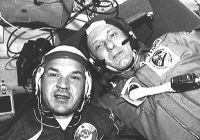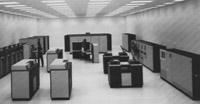Decade of the 80s Explosion of new technologies
2000/11/01 Kortabarria Olabarria, Beñardo - Elhuyar Zientzia Iturria: Elhuyar aldizkaria
Remember your first personal computer? The first pc? Despite being personal, the first generation computers were much bigger than the current ones, slower, more difficult to use... but from the first moment they were a great advance, since they facilitated much the way of working. Being a cheap device, it had a great success in companies, especially to make accounts and administrative tasks. The first was launched by IBM.
After the success of the computer, in 1983 IBM itself launched a new model, faster and with more possibilities. However, the IBM house was not the only one that realized the possibilities that personal computers could have, and that same year other companies began to build computers. Like the computer PC, in 1984 Macintosh computers were released. The TCP/IP language - Internet language - was also developed in that decade. At the end of the decade, Tim Berners-Lee developed the www. Of course, then the importance that could have in the future was not clearly perceived.
Despite the difficulty of knowing the importance of space exploration, in the 1980s there were several innovations such as ferries. The first was Columbia sent by NASA in 1981, but later became new, Challenger and Discovery. They were the first spacecraft that, after traveling to space and returning to Earth, could be reused. However, in the history of ferries there was a black event. Shortly after his departure on January 28, 1986, the ferry Challenger exploded in the air with the death of seven people.
The most spectacular space station so far, the famous Soviet Mir, is the achievement of the 1980s. It was put into orbit in 1986. In theory he already needed it on Earth, but it is still in orbit. Among the achievements were some spectacular, as in 1984 NASA astronauts repaired a satellite in orbit. It was the first time that these works were carried out in orbit. To do this, they used the robot arm that the Canadians made for ferries. In addition, astronaut Bruce McCandless was the first man to fly offline in space.
On the other hand, it was also intended to advance in astronomical research, so numerous instruments were sent into space: (1980) The Voyager 1 probe reached the area of Saturn. (1981) The Venera probe was sent to Venus. (1983) The Pioneer 10 probe came out of the Solar System. (1985) The giotto probe was sent into space to go to the surroundings of the Halley comet. (1989) The COBE observatory was launched with the aim of investigating the origin of the universe. (1989) The Galileo probe is sent into space to investigate Jupiter. (1989) The Voyager 2 probe reaches the area of Neptune.
Medicine has also focused on several occasions in this subordinate review. In this sense, in the 1980s there are remarkable facts. In 1982, in Salt Lake City, the man named Barney Clark was the world's first artificial heart, called Jarvik. The patient remained alive for 112 days. The laser was used in other technologies, but in 1985 it was used in operations. However, not everything was a breakthrough, such as AIDS, which appeared and identified in this decade. World health services found that in 1980 the African population and the community of American homoxesuales had begun to suffer a serious and rare disease. Three years later, in 1983, at the Pasteur Institute in France, researcher Montagnier managed to isolate and identify the AIDS virus, but Dr. Gallo of the United States announced that the discovery was his and not that of Montagnier. Although the identification of the AIDS virus can be considered a step forward, the emergence of a new disease is a delay. The World Health Organization dominated the naparrería in the decade, so it was replaced by a much more serious disease.
When talking about new technologies, they often seem to be current, but evolution has been annual. In the eighties, new tools emerged, which have become commonplace. These and many other events in the following lines: (1980) Philips invented a halogen bulb. (1981) Sony and Philips released the readers of compact discs, which forced the records to change format. (1981) Sony released the first digital cameras. (1981) First electronic tunnel effect microscope that allowed to visualize atoms one by one. Four years later, the first atomic microscope was developed. (1981) Daimler-Benz invented the car airbag system, but until 1988 it did not go on the market for its high price. (1985) British Joe Farman discovered the ozone layer hole, which had been a hole officially recognized that same year by the Geneva Convention. (1986) Fuji launches disposable photographic cameras. (1988) NASA's Goddar Institute unveiled the process of global warming of the Earth.

Gai honi buruzko eduki gehiago
Elhuyarrek garatutako teknologia






